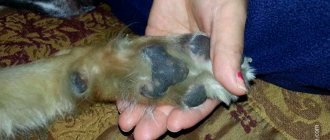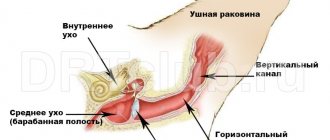Causes
Vaginitis in dogs is a disease that affects the genital organs of the animal. It is observed in females of different ages, as well as castrated and nulliparous. The prognosis for a sick animal is most often favorable, and in some cases, vaginitis goes away on its own and without treatment, the owners may not even notice it. However, in order to avoid complications and not reduce the dog’s quality of life, it is better to take timely measures to eliminate this disease.
Mostly young or mature bitches without experience of mating and childbirth suffer from it. Vaginitis is caused by the proliferation of bacteria (staphylococci, E. coli, streptococci, etc.), which are always normally present in the vaginal microflora. An increase in their number is provoked by a decrease in immunity, hormonal imbalance or injuries to the internal genital organs. The latter often appear after a difficult birth or damage from improper actions of people: injuries from palpation of the cervix or when trying to pull out a stuck puppy.
A decrease in immunity has its own reasons - infections, lack of vitamins, poor diet, stress, parasites, hypothermia. Poor hygiene can also cause vaginitis. Hormonal imbalance is observed mainly in bitches before puberty, but even after this period problems with the endocrine system are identified. For example, castrated individuals experience a decrease in estrogen.
Important! Puppies, after weaning from their mother's breast, moving to a new home and during quarantine due to vaccinations, have very unstable immunity. Therefore, they may develop vaginitis due to the slightest hypothermia.
Causes of pathology
In addition to the imbalance of microflora caused by decreased immunity (read how to increase immunity in a dog), the following factors can cause vaginitis in dogs:
- hormonal imbalance;
- violation of metabolic processes;
- previous infectious diseases;
- vaginal injuries during mating or birth of puppies;
- infection with sexually transmitted pathogens;
- foci of chronic infection in the body;
- violation of living and feeding conditions;
- use of aggressive medications;
- stress.
Classification
In veterinary practice, according to the course of the pathological process, it is customary to distinguish between acute and chronic forms of the disease. Depending on the causes and form of inflammation, vaginitis can be juvenile, serous, catarrhal, purulent, fibrous and gangrenous.
Juvenile
Often, clear, creamy vaginal discharge is detected in puppyhood. This type of inflammation is typical for animals that have not reached sexual maturity. The main cause of the disease is hormonal imbalance and metabolic disorders in a growing body.
In modern veterinary medicine, if necessary, the hormonal levels of young animals are corrected with the help of low concentration estrogens. In some cases, juvenile vaginitis goes away on its own without drug therapy.
Catarrhal
The mildest form of inflammation of the vaginal mucosa is catarrhal. The disease is characterized by cloudy, whitish, viscous discharge. With this form of inflammation, a sour, specific smell from the animal is noted, and small ulcers and hemorrhages are observed on the mucous membrane.
The prognosis for catarrhal vaginitis is favorable.
Purulent
When inflammation is complicated by streptococcal or staphylococcal microflora, catarrhal vaginitis becomes purulent. Yellow-greenish discharge with an unpleasant, pungent odor is observed from the vagina.
Purulent vaginitis
Fibrinous
Fibrinous vaginitis is characterized by the formation of fibrin films, which gives the vaginal secretion a whitish tint. Fibrin plaque accumulates on the surface of the mucous membrane, under which an ulcerative lesion of the organ is detected.
In this regard, veterinary experts do not recommend owners to remove the resulting plaque themselves. With this form of inflammation, the prognosis is cautious.
Gangrenous
The most severe form of the disease is gangrenous vaginitis. The pathological process is accompanied by melting of the mucous membrane under the influence of pyogenic microflora. Not only a modified secretion is released from the vagina, but also pieces of dead tissue. In the gangrenous form of the disease, a sharp putrid odor is observed from the animal. The prognosis may be unfavorable.
About juvenile vaginitis in puppies, watch this video:
Juvenile vaginitis
Diseases that occur among dogs of the juvenile (from the Latin juvenilis - young) or pre-pubertal period (before puberty) have various causes and become of great importance for the growing organism and the formation of a healthy adult animal. Among them, diseases of the reproductive (genital) system of dogs occupy a special place, which often cause concern to their owners.
A correct understanding of the causes of the disease helps in organizing adequate preventive and therapeutic (curative) measures. Unfortunately, there are frequent cases of adoption of unjustifiably aggressive therapeutic approaches, which not only do not eliminate the problem that has arisen, but can lead to undesirable consequences for the patient’s health.
The category of such diseases includes vaginitis in young dogs, the so-called juvenile or prepubertal vaginitis. This pathology is characterized by inflammation of the vaginal mucosa, which occurs due to endocrine disorders. The disease occurs in young females before the onset of puberty and is manifested by liquid transparent mucous discharge from the vagina, often with a creamy tint, or a thick creamy secretion of a yellow-green color, the abundance of which varies greatly individually. Vaginal discharge may be itchy, and dogs lick and nibble the genital area frequently and intensely.
In exceptional cases, the disease leads to a slight disturbance of the general condition, sometimes with an increase in temperature.
It is not difficult to differentiate this pathology from others (diseases of the uterus, infectious vaginitis of trichomoniasis or herpetic nature), since these diseases, as a rule, do not occur before the onset of puberty. These are vaginitis of endocrine nature! As for the bacterial factor in the development of the disease, there are nonspecific microorganisms - staphylococci, streptococci, E. coli and other ubiquitous bacteria that make up the normal flora of the vagina and contribute to the manifestation of vaginitis in dogs with a weakened immune system. Since the bacterial flora is almost always normal or with slight deviations, conducting bacteriological studies is of very limited value.
Factors that reduce the resistance of an animal include insufficient hygiene, unbalanced nutrition, vitamin deficiency (primarily vitamin A), post-vaccination reaction, stress (including hypothermia, change of owner, etc.) and concomitant diseases that reduce immunity, including parasitosis. In the treatment of juvenile vaginitis, it is necessary, first of all, to eliminate all of the above unfavorable factors. It should be noted that although this problem is relatively common, it seems to cause more trouble for owners than for their pets. Before the onset of puberty, therapy for endocrine-related vaginitis is usually ineffective. With minor discharge, no treatment is required; it stops spontaneously after the first heat and no relapses are observed. If the disease is accompanied by copious discharge with a disturbance in the general condition, then forced therapeutic measures will be required. The classic approach consists of local therapy (introduction of antiseptic and anti-inflammatory substances into the vagina), immunocorrection. In adult, sexually mature dogs, the appearance of vaginal discharge can be both normal (for example, during estrus) and pathological (diseases of the uterus and vagina of various origins), which requires your attention and immediate consultation with a veterinarian.
I would like to devote a few words to male individuals. Thus, in male dogs, mucopurulent discharge from the foreskin is often encountered, which is a widespread and normal phenomenon. All male dogs have a constant natural microflora, which is associated with discharge from the foreskin, and its composition can change daily. Many types of bacteria are present, including a hemolytic strain of streptococcus, but there is no evidence that the animal is sick with it and, accordingly, there is no reason to refuse mating. In puppies, an increase in the amount of preputial discharge is associated with an increase in sexual activity and related habits. It is possible that the characteristics of the animal’s immune status play a certain role. If the discharge becomes profuse, mixed with blood, and intense redness of the head of the penis, then it is necessary to examine the animal by a veterinarian to rule out inflammatory diseases, injuries, or malignant tumors. The selection of treatment depends on the type of pathology detected and its intensity. In the vast majority of cases, there are simple forms of balanopastitis (inflammation of the foreskin and glans penis), the treatment of which is based on the use of disinfectant and antibacterial solutions and ointments applied topically. Bacteriological studies are also uninformative, but in severe cases they are acceptable and help to select an effective antibiotic.
Thus, from the above, the conclusion suggests itself that this pathology is most often of a non-infectious nature. It can arise spontaneously and also stop. Therapy for this pathology is necessary in case of pronounced symptoms.
Treatment methods
Vaginitis is treated depending on what form it is. Treatment must be accompanied by the supervision of a veterinarian. Puppy vaginitis usually does not require treatment. After the first heat begins, it goes away on its own. In some cases, the veterinarian may prescribe estrogen in small doses. It is administered once every three days, the dosage ranges from 0.1 to 0.6 milligrams of active substance per injection.
In rare cases, treatment with hormonal drugs is used, since a positive result is not always observed, and a negative effect (hormonal imbalance) can be noticed in every situation when these drugs are used.
A swab is taken from the animal's vagina. This is necessary in order to correctly prescribe treatment. After collection, it is sent to the laboratory, where various tests are carried out to determine the sensitivity of the animal’s microflora to antimicrobial agents. The choice of drugs depends on the laboratory results obtained.
For sexually mature animals, local treatment without general antibiotic therapy is almost never used. These drugs are used for high severity of vaginitis (with diphtheritic and phlegmonous forms).
In case of catarrhal and purulent-catarrhal forms, ointments with bactericidal and anti-inflammatory properties are applied to the mucous membranes of the animal to stop the pathological process. For more convenient application of drugs, syringes or plastic spatulas are used.
Oxycort, synthomycin, streptocidal, prednisolone and other ointments can be used to treat vaginitis. The dosage for a single administration should be in the range of 5-10 milliliters.
In some situations, douching with a solution of Miramistin, potassium permanganate or Furacilin is used for treatment. Treatment is carried out daily until the animal is completely cured.
Treatment
Treatment tactics depend on the form of the disease and its causes. For the juvenile form, medications are not used. But some experts recommend administering low doses of estrogen to animals (0.1-0.6 mg for 3 days) in order to alleviate symptoms. As a rule, when hormonal balance is restored, the inflammation goes away.
Under no circumstances should you self-medicate! The disease will progress, the inflammation will spread to other organs and may further worsen the dog’s condition.
Systemic therapy
The choice of medications for the treatment of vaginitis should depend on the results of bacterial culture. With catarrhal form, you can do without the use of antibiotics. It is enough to give the dog products that help strengthen the immune system (vitamin complexes, immunomodulators) and carry out local treatment.
Taking antibiotics is justified if symptoms are severe. They are mainly prescribed for purulent, phlegmonous and gangrenous forms of inflammation.
More often they resort to broad-spectrum drugs:
- Amoxicillin;
- Penicillin;
- Cefazolin.
Local processing
To stop the development of the inflammatory process on the vaginal mucosa, it is recommended to use douching with disinfectant solutions, as well as applying ointments.
For douching the following is prescribed:
- Furacilin;
- Miramistin;
- Chlorhexidine;
- Potassium permanganate.
The procedure is carried out daily until complete recovery.
Ointments are applied to the affected area using a sterile spatula. Therapeutic liniments destroy bacterial microflora and promote restoration of the mucous membrane.
Effective ointments for vaginitis in dogs:
- Oxycort;
- Syntomycin;
- Streptocidal.
Dog care
In order for the dog to recover and recover faster, in addition to the use of medications, it needs to be provided with proper care.
Necessary:
- Find a warm and secluded place to rest, away from drafts.
- Avoid swimming in cold water.
- Avoid mating with a sick dog.
- Provide a balanced diet. At the same time, food should be easily digestible and dietary.
Why do dogs get wen and how to get rid of them? Learn about the reasons and methods for removing formations.
The symptoms and treatment methods for peripheral vestibular syndrome in dogs are written on this page.
Go to https://melkiesobaki.com/veterinariya/lechenie/liarsin.html and read the instructions for use of the drug Liarsin for small breed dogs.
Treatment of cystitis in dogs
Treatment of cystitis in dogs begins immediately, without paying attention to the severity of the signs, since the development of the disease occurs very quickly. At the beginning of therapy, broad-spectrum antibacterial drugs are used, and then (if necessary) a drug is selected that acts on a specific pathogen.
The complex of therapeutic measures includes medications of different groups, folk remedies, and diet therapy. Treatment of cystitis is carried out completely, without stopping even if you feel better and symptoms disappear. After this, a control diagnosis is performed. The dog owner needs to be prepared for the fact that the process may take 3 or more months.
Application of Stop Cystitis
A series of medications called “Stop Cystitis” has become very popular in the treatment of cystitis in dogs. It comes in two forms: tablets and suspension. In addition, there is a suspension of the product with the prefix “Bio”, which can be used to prevent inflammation of the bladder.
The use of Stop Cystitis allows you to quickly and effectively eliminate the symptoms of the disease and reduce inflammation. Thanks to the active components, represented by both herbal and medicinal compounds, the product has a multifaceted effect:
- eliminates the inflammatory process;
- removes sand from the bladder;
- prevents the proliferation of microbes;
- promotes urination.
The drug Stop-cystitis does not cause adverse reactions in the body and has no contraindications. Only occasionally can you see reviews that the dog has developed an intolerance to the medicine. To obtain a guaranteed result, the manufacturer recommends monitoring the timeliness of taking the drug and completing the course of treatment to the end.
Traditional medicine
Along with drug treatment at home, it is permissible to use folk remedies. But it is impossible to use them as an alternative, especially without confirming the diagnosis. Also, when choosing a particular collection and method, you must first consult with a veterinarian. Some plant compounds can enhance the effects of medications or, conversely, weaken them.
For cystitis in dogs, experts recommend using decoctions and infusions of diuretic plants: bearberry, horsetail, knotweed. Herbs such as lemon balm, mint, and chamomile cope well with pain. The following have an anti-inflammatory effect: parsley, marshmallow rhizome, St. John's wort, licorice.
To prepare the infusion, take one tablespoon of plant material (dry and crushed) and add ¼ liter of boiling water. After the composition has cooled, it is passed through cheesecloth or a sieve, while the remaining raw materials must be squeezed out. The infusion can be stored in the cold for 24 hours. It should be given to your pet twice a day in a dosage appropriate to the size of the dog (on average, 2-4 tablespoons). During treatment, you need to ensure that your four-legged friend does not have an allergic reaction or other symptoms indicating intolerance to the plant composition.
Diet
Diet is an essential component of the treatment complex for cystitis. From the very beginning of the disease, the dog needs to be “put on hunger” and given only water, while monitoring its condition. As a rule, in an acute form of the inflammatory process, the animal itself refuses food, but if there is an appetite, then after 1-2 days it is permissible to give lean broth (fat must be excluded from the diet for the duration of treatment).
In the future, the dog’s diet should consist mainly of vegetable and protein (to a lesser extent) products. Cereals, bread, and pastries are excluded. It is advisable to add vitamins to food, especially C, in the form of fruit drinks or syrups based on cranberries, rose hips, and currants. The pet may refuse such “treatment”; in this case, the syrup is poured using a syringe deep into the root of the tongue several times a day.
Dogs accustomed to dry food must also follow a diet. After starvation, they can be given special mixtures little by little. Large manufacturers such as Purina, Royal Canin and the like include in their product line feeds intended for animals with one or another disease.
It is important that your pet drinks plenty of water during treatment for cystitis. This will speed up the removal of toxic metabolic products from his body.
Prevention
To avoid illness, you need to know preventive measures for your pet.
The following points must be remembered:
- It is necessary to maintain dog hygiene and keep the animal clean;
- The mating of a dog must be carried out with a healthy male, so there is no risk of infection during sexual intercourse;
- It is necessary to maintain a balanced diet;
- Food must contain sufficient amounts of vitamins and microelements;
- It is necessary to monitor the general health and immunity of the animal;
- Timely vaccination can protect against many diseases.
Thus, by observing all of the above preventive measures, the owner will be able to protect his dog from this disease. If the disease is detected early, it can be treated quite easily. It is very important to notice the first symptoms at an early stage, otherwise the disease can lead to serious complications.











